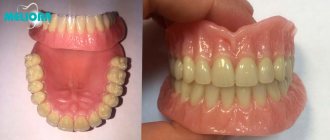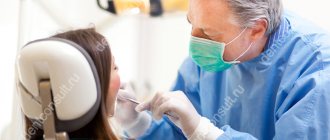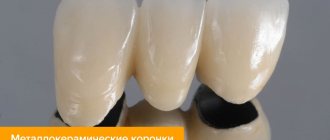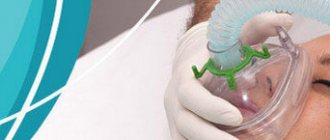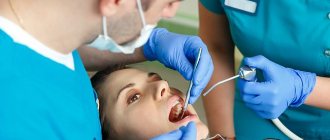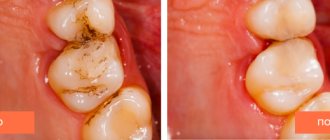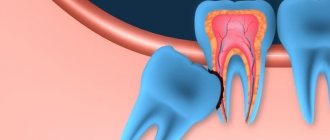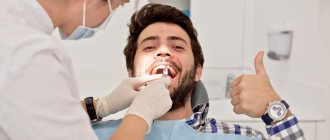How much treatment is possible in 1 visit?
The maximum duration of treatment under sedation is 14 consecutive hours
- Carry out comprehensive oral hygiene
- Cure caries, pulpitis or periodontitis
- Remove dental cysts
- Remove teeth, including wisdom teeth
- Fix the bracket system or aligners
- Install up to 16 implants
- Perform bone grafting on the lower jaw, sinus lift or revision of the maxillary sinus on the upper
- Install a comfortable and beautiful fixed prosthesis supported on your own teeth or on implants
How to treat all teeth in 1 day “in a dream”
Indications for oral hygiene
Plaque in hard-to-reach places mineralizes over time, increases in volume, grows along the crown and penetrates into the space under the gums. This leads to inflammation of the teeth and gums, tooth mobility and even tooth loss. Affordable professional oral hygiene helps prevent the following consequences:
- inflammatory processes in the gums, leading to periodontal disease and gingivitis;
- development of caries in hard-to-reach places;
- darkening and yellowing of tooth enamel.
We offer the best prices in Moscow for professional oral hygiene. Our clinic uses safe materials and modern equipment, which ensures painless and effective treatment.
A visit to a dental hygienist to remove soft and mineralized deposits is mandatory for those who are unable to fully clean the enamel on their own, for example:
- with dental implants to prevent their rejection;
- after the restoration procedure and installation of prostheses;
- with installed braces.
Experts recommend professional cleaning twice a year. This preventative measure will avoid costly treatment in the future.
Who chooses to have all their teeth treated “in their sleep”
For everyone who values their time and is accustomed to a certain quality of life, i.e. for everyone, although 10 years ago this format was of interest only to “big screen” stars and patients from other cities
- Super-busy Muscovites If you don’t have time to go to the dentist, like going to work, in traffic jams, in the evening, 2 times a week for six months to a year to get your teeth in order, and the problem is put off and put off for years
- Patients not from Moscow Every month we accept at least 10 patients from Russia and Europe. The operations are planned remotely; you only need to come for diagnostics and the operation itself. Very comfortably!
- Public people of all professions Privacy, quick results and the absence of visible signs of treatment on the face are why this technique has long been loved by show business stars, politicians, businessmen, and more recently bloggers
- Connoisseurs of comfort You can treat your teeth in the format of a SPA procedure. Fall asleep and wake up when it's all over. Not seeing or remembering the process. Do not hear medical odors and unpleasant sounds. Get the result and go home!
- Parents of responsible children If your parents are also the type who wouldn’t let a dentist near them at the drop of a hat, but walk around without teeth, then the only treatment format they can agree to is “all in 1 visit.” Checked!
- All those who do not like dentists Uncontrollable feelings of fear, panic reactions, negative experiences with a dentist in the past - all this is a direct indication for treatment in medicinal sleep
Professional oral hygiene
Professional oral hygiene is a set of measures carried out by a hygienist, which are aimed at the mechanical removal of dental plaque from the surface of the teeth and from under the gums. This includes professional teeth cleaning with ultrasound to remove tartar, plaque removal with an Air Flow device, polishing the tooth surface with special tools, as well as professional fluoridation of teeth.
Scheme of the action of ultrasound on tartar:
The principle of operation of the Air-Flow device on dental plaque:
Polishing teeth after removing tartar and plaque with a special fluoride-containing paste:
Gels for professional fluoridation using mouth guards for 3-5 minutes with fruit fillers:
A set of hygiene procedures is carried out for both children and adults. The frequency of teeth cleaning, whitening and other professional oral hygiene procedures is determined by the hygienist individually for each patient. Most people are recommended to have professional oral hygiene 1-2 times a year. Moreover, the professional hygiene course includes training in hygiene rules and the selection of individual products that are optimal for each patient. Agree, if your child learns to brush their teeth correctly from childhood, this will be the key to the health of his teeth and gums, his dazzling smile at any age, self-confidence, and, consequently, his success in life.
CLEAN TEETH DO NOT GET CARIES!
Many people develop brown plaque on their teeth from tea, coffee, and smoking. Salts from saliva settle on the resulting plaque, to which microbes from the oral cavity join. This is how tartar is formed. In tartar and plaque, pathological microorganisms multiply at tremendous speed, first causing inflammation of the gums, and then inflammation of the ligaments of the teeth and bone tissue around the teeth. Gingivitis develops first, the first sign of which is bleeding gums, and then periodontitis, in which the teeth begin to loosen. If immediate action is not taken, the development of periodontitis will lead to tooth loss.
Plaque and calculus before professional hygiene procedures:
After professional hygiene:
The development of gingivitis and periodontitis is influenced by the environment, living conditions, nutrition, and the general condition of the body. Moreover, the hereditary factor is important only in 2% of cases.
The frequency of deposition of tartar and plaque depends on the viscosity and composition of saliva, on the presence of bad habits (in particular, smoking), on the state of the bite (crowding of teeth), on the quality of the toothbrush, the frequency of personal hygiene, and the correct movements of the toothbrush while brushing the teeth ( not the time devoted to personal hygiene, as is popularly believed, but specifically the correct movements with the toothbrush). Naturally, the frequency of deposits of plaque and stones is also affected by diseases such as hypertension, urolithiasis, diabetes mellitus, liver diseases...
Dense, stained plaque and tartar cannot be completely removed by daily brushing. Therefore, it is necessary to regularly carry out hygiene procedures in the dental office.
For a clear demonstration to the patient and for a more thorough indication of the presence of plaque, the hygienist stains the teeth with a special liquid. In this case, clean teeth are not stained. “Fresh” plaque turns pink, and “old” plaque, which is more than a day old, turns purple. And the patient can see for himself those areas that need more thorough professional oral hygiene.
Caries and periodontal diseases develop only in conditions of insufficient oral hygiene. Prevention of caries and periodontal diseases is regular professional hygiene . Removing tartar is just as necessary as treating caries.
Stages of treatment
Below we have provided a sequence of standard activities for successful planning and treatment. Of course, some meetings can be combined into one visit, and in some cases vice versa. Please do not treat the listed stages literally, as imperative norms.
Initial consultation
The purpose of the initial consultation is to determine the overall treatment strategy.
- Identify patient complaints and wishes
- Determine the color and condition of tooth enamel
- Visually assess the condition of soft tissues (the gum is not visible on the CT image)
- Diagnose the functionality of the joint
- Carry out a photo protocol for further work on the smile design, taking into account facial features
The standard duration of the initial consultation at the Center is 60 minutes, which can be increased at the patient’s request. It is enough to inform the operator about this by phone when making an appointment.
In accordance with the Center’s Unified Quality Standards, initial consultations are carried out only if there is a high-quality 3D X-ray computed tomography image. If you already have a photo on CD or DVD that is no older than 8 weeks, take it with you. If you don’t have a photo, you can take one with us before your consultation.
If you do not live in Moscow, but are considering our Center as your future medical institution, please send a CT scan to the clinic’s email. Our doctors do not make diagnoses or provide consultations remotely, but they will be able to draw up several preliminary treatment plans with approximate time frames.
Initial consultations at the Center are paid. We do not encourage “luring” patients with free consultations for the purpose of selling services. Our doctors are engaged in medicine, not business, so their time is paid. A patient who contacts us for the first time can be sure that he will receive an objective opinion.
Repeated consultation
The purpose of the repeat consultation is to determine treatment tactics. At our Center, several doctors always take part in planning. This takes some time. We always ask patients to treat this phenomenon with understanding. Below we will try to justify why time and medical collegiality are needed.
- Orthopedist As a rule, during complex treatment, the initial consultation is always carried out by an orthopedic dentist and, by default, becomes the responsible attending physician for the patient . The orthopedist determines which specialized specialists need to be involved to plan treatment.
- The endodontist determines the consistency of the patient's remaining teeth. This is perhaps the most important part of planning, because... Excessive hopes for the canals of preserved teeth can lead to breakdowns, complications and the need to redo something within a year. Often, in order to accurately assess the durability of a tooth, especially one previously treated in third-party medical institutions long ago, it is necessary to conduct additional diagnostics using a microscope.
- Dental and maxillofacial surgeon Evaluates the condition of bone tissue, gums and maxillary sinuses. Determines the degree of difficulty of tooth extraction, if necessary, positions implants, plans work with soft tissues.
- Orthodontist Comes to the rescue with malocclusion, problems with the temporomandibular joint and in cases where there are indications for straightening teeth, for example, in order to eliminate crowding.
- Periodontist In many cases, we recommend treatment only after complex periodontal therapy because inflammatory processes in the soft tissues can, firstly, lead to immediate postoperative complications, and secondly, affect the durability of treatment results. We strive to ensure that our treatment lasts the patient's entire life.
Coordination of treatment tactics with 3-4 different specialists has been a completely standard practice in our Center for many, many years. Doctors may not recognize you by sight, but they remember your CT scan very well.
Of course, if you just need to cure caries on 7-8 teeth under sedation, one consultation with a dentist-therapist and an acquaintance with our anesthesiologist-resuscitator is enough, and already at the second meeting you will leave the clinic with complete sanitation of the oral cavity.
Fundamental diagnostics
In order for new teeth to last a lifetime, all the individual characteristics of the patient must be taken into account. For this purpose, various targeted in-depth diagnostic examinations of the oral cavity are carried out.
- Radiography Based on a computed tomography image, the condition of the bone tissue and the condition of the maxillary sinuses are determined, the dislocation of the implants, their size, position, and the possibility of performing implantation simultaneously with removal or with bone grafting are planned.
- Taking silicone impressions and making diagnostic models Allows you to obtain a copy of the patient’s teeth, the minimum necessary measure for orthopedic and orthodontic treatment.
- Digital 3D scanning of the oral cavity A modern and more accurate alternative to silicone impressions and plaster models. Allows you to instantly obtain a digital model on a computer for transmission to a dental technician, planning orthodontic treatment and making designs for future teeth.
- High-precision examination using a facebow and articulator Establishes the true trajectory of the lower jaw. Due to tooth wear, prolonged absence, hypertonicity of the jaw muscles and many other reasons, the lower jaw “loses” anatomical landmarks. Prosthetics “by eye” in such cases leads not only to the fact that the expensive prosthesis will not last long, but also to the development in the near future of arthrosis, arthritis, headaches and difficulty opening or closing the mouth.
- Neuromuscular TENS diagnostics It is used in cases where the tone of the jaw muscles is so increased that it is impossible to establish a reliable trajectory of jaw movement. The first signs of hypertonicity are bruxism, headaches, sleep disturbances, and discomfort in the cervical spine. TENS therapy using microcurrent impulses relaxes muscles, relieves spasms and allows for diagnostics.
- Inspection of canals under a microscope Allows you to determine with 99% accuracy whether it will be possible to save it with periodontitis or a cyst or not, as well as how many years a previously treated tooth will last in a third-party medical institution.
- Anesthesiological history In some cases, before the operation, a personal meeting with the Center’s staff anesthesiologist is required to clarify the anamnesis.
Planning the operation
A CT scan, photographs, and the results of additional diagnostic studies are collected together and a detailed treatment plan or several plans are drawn up.
If several visits are expected, then each is planned separately, with the timing and amount of the patient’s costs for each stage. As part of the operating day, the sequence of participation of each doctor is approved, and the required amount of time is recorded in the schedule.
The orthopedic dentist, using a special program, models the design of the future smile, produces a digital wax-up and coordinates the color and shape of the teeth with the patient before treatment begins. If necessary, a mock-up is made, a model of future teeth for fitting in the oral cavity, with which you can take a photo, show it to your spouse, leave the clinic and make a decision in a relaxed atmosphere.
The terms, cost of treatment, treatment procedure and warranty obligations for each of the treatment options, if there are several, are approved.
Operation
Complex treatment is carried out under sedation, a state of artificial medicinal sleep.
Sedation is not anesthesia; narcotics are not used, only ultra-short-acting hypnotics, such as propofol and diprivan. “Coming out” of sedation takes from 10 to 30 minutes and you can go home. Unlike anesthesia, breathing is not suppressed, there is no nausea, dizziness, and there is no need to stay in the hospital after the operation.
- We recommend planning the start of treatment in the morning.
- Restrictions: do not drink water 2 hours before operations under sedation, do not eat food 4 hours before.
- The clinic has a recovery room where you can rest when the doctors are finished.
- There is no need to run to pharmacies after treatment. All necessary medications and care products are provided within the Center.
Branded accelerated rehabilitation
The Center uses a unique proprietary rehabilitation complex to eliminate signs of surgical treatment. A course of 30-40 minutes completely eliminates swelling, hematomas and significantly reduces postoperative pain. The course uses microcurrent and injection therapy, which gives an immediate effect.
PiezoSurgery® – ultrasound surgery
We work with bone tissue and remove teeth using a minimally invasive piezosurgical protocol
- Minimal trauma - the bone is not damaged, it is delicately softened
- The device affects only hard tissues, damage to the sinus membrane is excluded during sinus lifting
Cost of treatment
A special feature of the estimate for dental treatment for 1 day is the absence of stages of payment and the inclusion of the cost of several hours of sedation. Otherwise, the assessment procedure is no different from the traditional procedure. At the initial consultation, the doctor collects anamnesis, assesses the general condition of the oral cavity and joints, analyzes a computed tomography scan and makes a diagnosis. At this stage, the approximate order of expenses can always be determined. For a more accurate assessment, the opinion of related specialists will be required.
In 90% of cases, patients seek help under the “one visit” program with complex problems, so the cost is summed up from therapeutic, surgical, and orthopedic work.
Sign up for a paid consultation with the leading specialists of the Center or with the Chief Physician Dmitry Valerievich Levin and get an unbiased opinion about the treatment specifically in your case.
Types of oral hygiene procedures
In Moscow, oral hygiene is performed by our specialists with higher education and many years of experience. The list of services provided in our medical center is presented in the table below.
| Procedure | Description | Advantages |
| Ultrasound removal of tartar | Removing large particles of mineralized plaque on enamel, cleaning the cervical area | Fast, painless. |
| Air Flow Cleaning | Removing soft pigmented plaque by spraying under pressure a fine mixture of water and structured soda. | Gentle and effective cleansing, lightening the enamel tone by 2-3 shades, eliminating unpleasant odors, preventing inflammatory diseases. |
| Polishing a dental crown after stone removal | Applying a special polishing paste to the crown | Elimination of roughness to prevent plaque re-formation |
| Strengthening enamel | Application of compounds with fluorine and calcium | Increasing the strength and resistance of enamel to an acidic environment. |
Prices for oral hygiene in our dentistry are distinguished by their democratic and affordable prices..
The complex of these procedures strengthens local immunity, reduces the number of bacteria, and minimizes the risk of developing dental and periodontal diseases.
